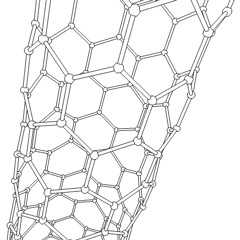Facts for Kids
Carbon nanotubes are advanced materials with remarkable strength, electrical conductivity, and thermal properties, making them suitable for a wide range of applications.
Overview
Synthesis Methods
Ethical Considerations
Structure And Properties
Types Of Carbon Nanotubes
Applications In Technology
Future Research Directions
Impacts On Health And Environment
Comparisons With Other Nanomaterials

Inside this Article
Electrical Conductivity
Strength Of Materials
Space Exploration
Electronics
Technology
Carbon
People
Nature
Health
Did you know?
🧬 Carbon nanotubes are cylindrical nanostructures made of carbon atoms arranged in a hexagonal lattice.
🌬️ They have extraordinary mechanical strength, being over 100 times stronger than steel.
⚡ Carbon nanotubes exhibit excellent electrical conductivity, making them useful in electronics.
🔥 With high thermal conductivity, they are effective materials for heat management applications.
🔭 Carbon nanotubes can be single-walled (SWNT) or multi-walled (MWNT), differing in structure and properties.
🔋 They have potential applications in energy storage, including batteries and supercapacitors.
🧪 Due to their large surface area, carbon nanotubes are effective in drug delivery systems.
🌐 Their unique properties allow for use in advanced materials and composites.
📈 Carbon nanotubes can be synthesized using methods like chemical vapor deposition (CVD) and arc discharge.
🚀 Possible applications of carbon nanotubes include aerospace, nanotechnology, and biosensors.
Introduction
They were discovered in 1991 by a scientist named Sumio Iijima in Japan. These amazing structures look like rolled-up sheets of graphene, which is a flat one-atom-thick layer of carbon. Carbon nanotubes are special because they are super strong, yet very light. If you could stretch a carbon nanotube, it would be stronger than steel! 💪
Scientists are excited about how these materials can be used in technology and medicine.
Synthesis Methods
One popular way is called chemical vapor deposition (CVD), which involves heating up carbon-containing gases to create the tubes. Another method is laser ablation, where a laser vaporizes carbon material to form nanotubes! ⚡
Finally, there’s arc discharge, where electricity is passed through carbon to create carbon nanotubes. These methods help scientists make pure and beautiful nanotubes for research and new inventions!
Ethical Considerations
They ask questions about safety and how to use these materials responsibly. It's important to consider whether new technologies could harm people or the planet. 🌳
Researchers and industry leaders are working to create guidelines that ensure carbon nanotubes are safe for everyone. By doing this, they can enjoy the benefits of carbon nanotubes while keeping our environment and communities healthy!
Structure And Properties
️ They come in two main shapes: single-walled nanotubes, which have one layer of carbon atoms, and multi-walled nanotubes, which have several layers stacked together. The walls are like cylinders made of hexagons, similar to a honeycomb! 🍯
They are also excellent electricity conductors, making them useful for many electronic devices. Their incredible strength and lightweight nature help create stronger materials while using less weight!
Types Of Carbon Nanotubes
SWCNTs have just one tube and are about one nanometer wide, like one strand of hair! MWCNTs, on the other hand, can have several tubes layered on top of each other, which makes them thicker and stronger. Both types have amazing properties, but they’re used differently. For example, SWCNTs are great for electronics, while MWCNTs are often used in stronger materials like sports equipment. 🏀
Applications In Technology
For example, they are used in batteries to make them last longer and charge faster. They can also improve the strength of materials, making lightweight and durable sports gear. ⚽
In computers, carbon nanotubes can help make super-fast chips, which would allow computers to run faster and use less energy. There’s even research on using them in medical devices, like tiny sensors for detecting diseases! 🩺
Future Research Directions
They are looking for new ways to use them, like creating stronger materials for buildings or even using them in space exploration. 🚀
Researchers are also exploring how to combine carbon nanotubes with other materials to create special blends. These materials could help make better batteries and sensors! With more discoveries, we might find even more amazing uses for carbon nanotubes in our everyday lives.
Impacts On Health And Environment
Some researchers worry they might be harmful if inhaled, just like smoke. But more studies are needed to understand how they impact our health. It’s important for scientists to be careful and find out how to use them safely! 🌱
Additionally, making carbon nanotubes should not pollute the environment, so researchers are working on eco-friendly methods to create them.
Comparisons With Other Nanomaterials
Other nanomaterials include silver nanoparticles and titanium dioxide. While silver nanoparticles help make things antibacterial and titanium dioxide helps with sunscreens, carbon nanotubes shine when it comes to strength and electrical conductivity. 💡
Each nanomaterial has unique properties, but carbon nanotubes stand out due to their incredible strength-to-weight ratio and ability to conduct electricity!

